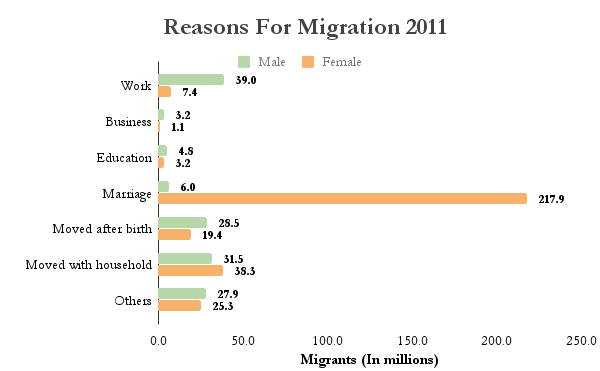Women migrating for work and education between 2001 and 2011 grew at a rate that outpaced men who moved for similar reasons, shows an IndiaSpend analysis of Census data.
In this period, the number of women migrating for work grew by 101 percent , more than double the growth rate for men (48.7 percent ). Also, the number of women who cited business as a reason for migration increased by 153 percent in 2001-11, more than four times the rate for men (35 percent).
Women’s migration is still driven primarily by marriage. In absolute numbers, 97 percent of Indians migrating for marriage were women in Census 2011, IndiaSpend reported on 15 December 2016, a marginal drop from 98.6 percent in Census 2001.
Scholars have, however, argued that women do work post-migration even if their first reason for the move was matrimony.
“Women’s migration is not adequately captured because the surveys ask for only one reason for migration to be stated. This is usually stated as marriage and the secondary reason, that is finding work at the destination, may not be mentioned,” Priya Deshingkar and Shaheen Akhtar of London’s Overseas Development Institute’s had argued in an April 2009 UNDP paper.
“Many of the women who migrate for marriage do join the labour force,” said a January 2017 housing and urban poverty alleviation ministry report on migration, echoing Deshingkar and Akhtar.
Between Censuses 2001 and 2011, the number of men who migrated for education rose by 101 percent, less than half that for women, at 229 percent.
Migration for work usually results in relief from poverty even if it means a rough life in India’s metros, IndiaSpend reported on 13 June 2016. A migrant from Maharashtra’s drought-stricken Marathwada region, for example, triples her income temporarily after moving to Mumbai, according to the report.
A two-round survey of 904 households spread across Bihar in 1998-2000 and 2011 by Amrita Datta at the Institute for Human Development showed that on average households with migrants earned about Rs 11,000 more than households without migrants in 2011, the business newspaper Mint reported on 4 August 2016. The study was published in the Economic and Political Weekly on 30 July 2016.
Marriage Remains the Biggest Reason for Migration
In the 11 years to 2011, the rise in the number of men who migrated for marriage grew by 176.6 percent , more than four times the growth rate for women who moved for similar reasons (41.5 percent).
Between the two Censuses, marriage has remained the biggest reason for migration, dropping marginally to 49.35 percent of all migrants in 2011 from 50 percent in 2001.
The number of men saying they migrated either after birth or with the household rose at a slightly faster pace than women in 2001-11: 207 percent and 74 percent for the first reason and 199 percent and 54 percent for the latter.
Numbers dropped for both genders reporting other reasons in 2001-11, but it fell more for women (17.5 percent) than men (15 percent).
(This article was originally published in IndiaSpend, and has been reproduced here with permission.)
(At The Quint, we are answerable only to our audience. Play an active role in shaping our journalism by becoming a member. Because the truth is worth it.)

